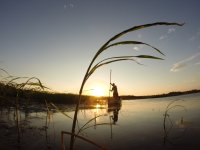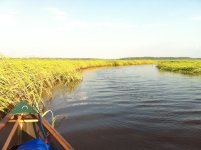While visiting my daughter here in Maine, she showed me this article in the local paper.
Up the creek with no paddle? Use a pole
 Bob Holtzman | Courtesy of Bob Holtzman
Bob Holtzman | Courtesy of Bob Holtzman
 Bob Holtzman | Courtesy of Bob Holtzman
Bob Holtzman | Courtesy of Bob Holtzman
Mike Patterson poles a canoe up and over a drop on the Passagassawakeag River during a recent canoe poling clinic.
 Bob Holtzman | Courtesy of Bob Holtzman
Bob Holtzman | Courtesy of Bob Holtzman
Canoeist Cynthia Morgan shifts her weight and uses a setting pole as she descends a series of drops on the Marsh Stream during a recent canoe poling clinic.
Nine canoes gather above a series of drops in the river. In some of them are professional guides. In others, canoeists of varying experience. One is piloted by a young woman who has never been in a canoe on moving water before. The canoeists carefully scout a path through the rocks and rapids then, one by one, they descend the whitewater. The canoeists are all standing in their boats. None of them capsize.
None are holding paddles either. Instead, they grasp long “setting” poles — slender, 10- or 12-foot shafts of ash, tipped with a steel cap or “shoe” at one end. And they use those poles to pick their way through the rapids, pushing off against rocks, steering by sweeping the pole through the water — even stopping the canoe dead in the current by jamming the shoe against the river bottom while they ponder their next move.
“That’s a great thing about the pole,” says canoe guide Mike Patterson. “You can stop the canoe and give yourself time to reposition it.” Patterson was leading a two-day instructional clinic in canoe poling last weekend through Wilds of Maine Guide Service, the business he and his wife, Shauna, run out of Belfast. As a female poler, Shauna is proud to belong to the select group of “chicks with sticks.”
Poling, says Mike, has a long history in Maine, where early 20th-century lumber camps had to be provisioned by canoe. Paddling a loaded canoe against the current was often impossible, but pushing it upstream with a pole against the river bottom proved practical, and standing up was the only way to exert sufficient leverage. “Never stand up in a canoe” is a truism taught at many a summer camp to novice canoeists, but as the participants in Patterson’s clinic learned, it’s advice that can be safely ignored with a bit of training.
After launching the canoes on Saturday morning, the clinic began on a quiet stretch of Marsh Stream near Brooks, where Patterson showed us how and where to stand in the canoe, how to set the pole against the bottom to maneuver and how the pole can be almost as effective as a paddle in water that’s too deep to reach the bottom of with the pole.
Then the group proceeded downstream with Patterson leading the way. Over the first couple of miles, the stream presented a nice mix of learning opportunities: some stretches were deep and easy, where we swept the pole through the water much like a paddle. Other sections were shallow or narrow, where we had to maneuver constantly, setting the pole against the bottom to avoid rocks or stay in the channel. Eventually, the group was taking their canoes over drops of a foot or so with confidence, culminating in the close series of drops that descended some six feet along a 120-foot stretch of river.
Before tackling that challenge, we pulled the boats to shore, got out, and examined the run, with
Mike suggesting the most promising paths past the obstacles. Some of us were more than a little nervous, but the day’s earlier experience and Patterson’s training had prepared us well. Every canoeist made it through, upright and exuberant.
On Sunday, the group launched its canoes on the upper reaches of the Passagassawakeag River in Waldo and, at the first drop, Patterson demonstrated the pole’s capability for upstream travel. Facing upstream and carefully maintaining the a tight angle between the bow of his canoe and the current, Patterson — who is by no means a large man — showed how a canoe can ascend a foot-high drop against a rushing current. Several students attempted to duplicate the feat, but that proved to be beyond our novice technique, and each of us was pushed back.
The rest of the five-mile river trip did, however, test our strength and determination, as well as our setting skills. The river was low, and in some places the channel meandered aimlessly. In
sections where a canoe paddle wouldn’t have enough depth to work, the poles continued to see us through, allowing vigorous forward and steering thrusts in just inches of water. Even where there was no channel at all, we could force our way right over rocks by leaning hard on the poles. The plastic canoe hulls took a few scratches but didn’t complain.
Neither did the clinic participants. In two days we had learned a skill known to few canoeists, one that increases our ability to “paddle” narrow streams, pick our way safely through whitewater and one that, with more practice, will enable us to travel against currents that stop other canoeists dead in their tracks.
And that, according to Patterson, opens up the possibility of river travel without the canoeist’s perennial problem of arranging for a car shuttle between the put-in and the take-out. A canoeist can pole upstream in the morning and float downstream in the afternoon, ending the trip right where he or she left the car.
3.15.2013
Up the creek with no paddle? Use a pole
 Bob Holtzman | Courtesy of Bob Holtzman
Bob Holtzman | Courtesy of Bob Holtzman Bob Holtzman | Courtesy of Bob Holtzman
Bob Holtzman | Courtesy of Bob HoltzmanMike Patterson poles a canoe up and over a drop on the Passagassawakeag River during a recent canoe poling clinic.
 Bob Holtzman | Courtesy of Bob Holtzman
Bob Holtzman | Courtesy of Bob HoltzmanCanoeist Cynthia Morgan shifts her weight and uses a setting pole as she descends a series of drops on the Marsh Stream during a recent canoe poling clinic.
Nine canoes gather above a series of drops in the river. In some of them are professional guides. In others, canoeists of varying experience. One is piloted by a young woman who has never been in a canoe on moving water before. The canoeists carefully scout a path through the rocks and rapids then, one by one, they descend the whitewater. The canoeists are all standing in their boats. None of them capsize.
None are holding paddles either. Instead, they grasp long “setting” poles — slender, 10- or 12-foot shafts of ash, tipped with a steel cap or “shoe” at one end. And they use those poles to pick their way through the rapids, pushing off against rocks, steering by sweeping the pole through the water — even stopping the canoe dead in the current by jamming the shoe against the river bottom while they ponder their next move.
“That’s a great thing about the pole,” says canoe guide Mike Patterson. “You can stop the canoe and give yourself time to reposition it.” Patterson was leading a two-day instructional clinic in canoe poling last weekend through Wilds of Maine Guide Service, the business he and his wife, Shauna, run out of Belfast. As a female poler, Shauna is proud to belong to the select group of “chicks with sticks.”
Poling, says Mike, has a long history in Maine, where early 20th-century lumber camps had to be provisioned by canoe. Paddling a loaded canoe against the current was often impossible, but pushing it upstream with a pole against the river bottom proved practical, and standing up was the only way to exert sufficient leverage. “Never stand up in a canoe” is a truism taught at many a summer camp to novice canoeists, but as the participants in Patterson’s clinic learned, it’s advice that can be safely ignored with a bit of training.
After launching the canoes on Saturday morning, the clinic began on a quiet stretch of Marsh Stream near Brooks, where Patterson showed us how and where to stand in the canoe, how to set the pole against the bottom to maneuver and how the pole can be almost as effective as a paddle in water that’s too deep to reach the bottom of with the pole.
Then the group proceeded downstream with Patterson leading the way. Over the first couple of miles, the stream presented a nice mix of learning opportunities: some stretches were deep and easy, where we swept the pole through the water much like a paddle. Other sections were shallow or narrow, where we had to maneuver constantly, setting the pole against the bottom to avoid rocks or stay in the channel. Eventually, the group was taking their canoes over drops of a foot or so with confidence, culminating in the close series of drops that descended some six feet along a 120-foot stretch of river.
Before tackling that challenge, we pulled the boats to shore, got out, and examined the run, with
Mike suggesting the most promising paths past the obstacles. Some of us were more than a little nervous, but the day’s earlier experience and Patterson’s training had prepared us well. Every canoeist made it through, upright and exuberant.
On Sunday, the group launched its canoes on the upper reaches of the Passagassawakeag River in Waldo and, at the first drop, Patterson demonstrated the pole’s capability for upstream travel. Facing upstream and carefully maintaining the a tight angle between the bow of his canoe and the current, Patterson — who is by no means a large man — showed how a canoe can ascend a foot-high drop against a rushing current. Several students attempted to duplicate the feat, but that proved to be beyond our novice technique, and each of us was pushed back.
The rest of the five-mile river trip did, however, test our strength and determination, as well as our setting skills. The river was low, and in some places the channel meandered aimlessly. In
sections where a canoe paddle wouldn’t have enough depth to work, the poles continued to see us through, allowing vigorous forward and steering thrusts in just inches of water. Even where there was no channel at all, we could force our way right over rocks by leaning hard on the poles. The plastic canoe hulls took a few scratches but didn’t complain.
Neither did the clinic participants. In two days we had learned a skill known to few canoeists, one that increases our ability to “paddle” narrow streams, pick our way safely through whitewater and one that, with more practice, will enable us to travel against currents that stop other canoeists dead in their tracks.
And that, according to Patterson, opens up the possibility of river travel without the canoeist’s perennial problem of arranging for a car shuttle between the put-in and the take-out. A canoeist can pole upstream in the morning and float downstream in the afternoon, ending the trip right where he or she left the car.
3.15.2013


